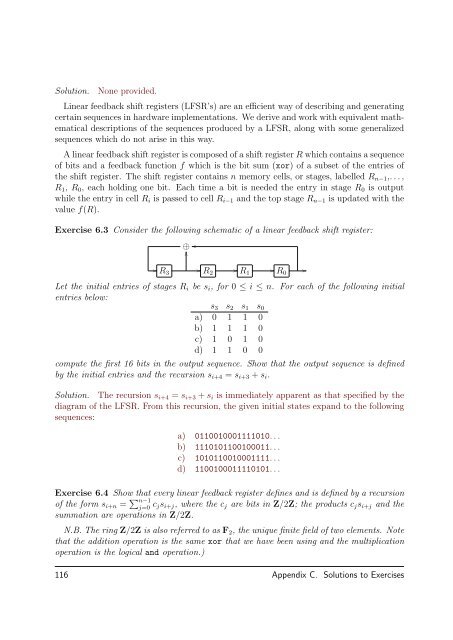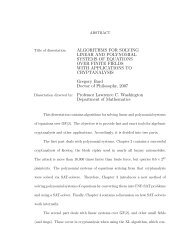Cryptography - Sage
Cryptography - Sage
Cryptography - Sage
Create successful ePaper yourself
Turn your PDF publications into a flip-book with our unique Google optimized e-Paper software.
Solution.None provided.Linear feedback shift registers (LFSR’s) are an efficient way of describing and generatingcertain sequences in hardware implementations. We derive and work with equivalent mathematicaldescriptions of the sequences produced by a LFSR, along with some generalizedsequences which do not arise in this way.A linear feedback shift register is composed of a shift register R which contains a sequenceof bits and a feedback function f which is the bit sum (xor) of a subset of the entries ofthe shift register. The shift register contains n memory cells, or stages, labelled R n−1 ,. . . ,R 1 , R 0 , each holding one bit. Each time a bit is needed the entry in stage R 0 is outputwhile the entry in cell R i is passed to cell R i−1 and the top stage R n−1 is updated with thevalue f(R).Exercise 6.3 Consider the following schematic of a linear feedback shift register: R 3⊕ R 2 R 1 R 0Let the initial entries of stages R i be s i , for 0 ≤ i ≤ n. For each of the following initialentries below:s 3 s 2 s 1 s 0a) 0 1 1 0b) 1 1 1 0c) 1 0 1 0d) 1 1 0 0compute the first 16 bits in the output sequence. Show that the output sequence is definedby the initial entries and the recursion s i+4 = s i+3 + s i .Solution. The recursion s i+4 = s i+3 + s i is immediately apparent as that specified by thediagram of the LFSR. From this recursion, the given initial states expand to the followingsequences:a) 0110010001111010. . .b) 1110101100100011. . .c) 1010110010001111. . .d) 1100100011110101. . .Exercise 6.4 Show that every linear feedback register defines and is defined by a recursionof the form s i+n = ∑ n−1j=0 c js i+j , where the c j are bits in Z/2Z; the products c j s i+j and thesummation are operations in Z/2Z.N.B. The ring Z/2Z is also referred to as F 2 , the unique finite field of two elements. Notethat the addition operation is the same xor that we have been using and the multiplicationoperation is the logical and operation.)116 Appendix C. Solutions to Exercises
















